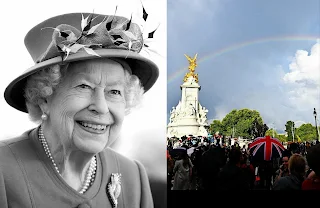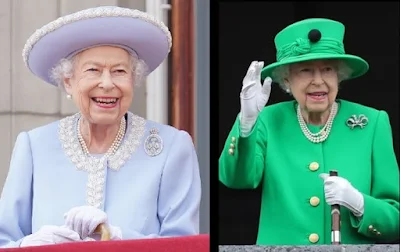Her Majesty, Queen Elizabeth II, the longest-reigning monarch in British history, and the longest-serving Head of State died peacefully at her summer residence in Balmoral estate. Buckingham Palace released the official statement at 6:30 in the evening on September 8, 2022.
Her reign was the most unique, not only it lasted 70 years, longer than any British Sovereign ahead of her, but she was also the second British monarch in history after her ancestor, King George I, the founder of the House of Hanover in Britain, who was not on British soil when she ascended the throne.
The Queen and Prince Philip were in Kenya when her father, King George VI, died in his sleep on the early morning of February 6, 1952. It was at their Kenya hotel that Her Majesty read the statement of her accession.
She was also the second monarch after King George I (who died in 1727 in Hanover, Germany after suffering from a stroke while on a vacation) who was not in England at the time of death. Her Majesty died in Scotland.
 |
| A rainbow appeared over Buckingham Palace following the announcement of Her Majesty's death on Sept 8 |
The Unexpected Queen
The Queen was not expected to ascend the British throne. At the time of her birth, her father, Prince Bertie, Duke of York, was only second in line to the throne after his older brother, Prince David, Prince of Wales, and thus, was not in direct succession.
She was born on April 21 1926 at the London home of her maternal grandfather, the 14th Earl of Strathmore and Kinghorne.
Her birth was celebrated with a gun salute but did not attract so much interest from the public and the media due to the fact that she was not expected to become Queen.
However, succeeding circumstances paved the way for her to rise to the British throne.
On December 11, 1936, when she was only 10 years old, her maternal uncle, King Edward VIII, voluntarily abdicated the throne in favor of her father, who became King George VI.
Princess Elizabeth suddenly became the heir presumptive, and first-in-line of succession to the British throne, less than 16 years later, she ascended the throne as Elizabeth II.
Just three months ago, Her Majesty had a week-long celebration of her Platinum Jubilee. She had two major appearances during the celebration on the balcony of Buckingham Palace: During the fly-past presentation of the Royal Airforce at Trooping the Colors and at the conclusion of the Platinum Pageant.
The London Bridge and The Operation Unicorn
Operation London Bridge, the plan outlining Britain’s next steps if the Queen dies, has been in the works for years, and several reports have pieced together the details of what is likely to unfold with the queen’s funeral arrangements and the crown.
However, there was a contingency plan outlined if Her Majesty will die in Balmoral, and became known as Operation Unicorn.
What is Operation London Bridge?
Details of Operation London Bridge was leaked to the press in May 2017, describing the events and details during the 10-day period following the death of the Queen.
Highlights are below based on information from the Foreign Press Association of London:
- Following the Queen's death, her eldest son and heir, The Prince of Wales, automatically becomes the new King.
- The new king will receive Parliament's motion of condolence at Westminster Hall, then depart on a tour of the kingdom to meet his people.
- The procession of the coffin from Buckingham Palace to the Palace of Westminster will take place, followed by a service in Westminster Hall.
- The queen lies in state at Westminster Hall.
- The queen's state funeral will be at Westminster Abbey. The day will be declared a Day of National Mourning and two minutes of silence will be marked across the nation.
What is Operation Unicorn?
Operation Unicorn was the plan B drawn as a contingency measure should the Queen die in Balmoral while on a summer holiday.
The unicorn is the national animal of Scotland and forms part of the royal coat of arms, along with the lion of England.
Highlights of the Operation Unicorn:
- Thursday will be declared as "D-Day" and each following day leading up to the funeral will be referred to as "D+1," "D+2" till the tenth of her death.
- As per one official memo, the code for conveying the message of the Queen's death is "London bridge is down." What will follow is a vast security operation to manage crowds and travel chaos, the report said.
- Aspects of Operation London Bridge were already activated such as BBC presenters wearing black and channels switching to rolling news.
- The Parliament, the neighboring Palace of Holyroodhouse, and St Giles' Cathedral will be the main focal points," according to the reports. The Palace of Holyroodhouse is the monarch's official residence in Edinburgh, and the cathedral is one of the Scottish capital's most important medieval churches.
- Parliamentary business will be immediately suspended and politicians will prepare a motion of condolence and get ready for a state funeral.
- Members of the public will sign a book of condolence at the parliament at Holyrood.
- A source in the parliament told The Herald that the Queen's death in Scotland could result in hundreds of thousands of people arriving there.
- Her body will rest at Holyroodhouse, following which her coffin will be carried to the cathedral on the Royal Mile (in Edinburgh)," the newspaper wrote.
- Her body will then be placed on the Royal Train at Waverley station in Edinburgh for a journey down the east coast mainline to London.
- Ten days after Queen's death, the newly appointed UK Prime Minister Liz Truss will be the first member of the government to make a statement.
- Aside from the statement from the PM and other members of the government, gun salutes will be arranged at all saluting stations.
Subsequently, Liz Truss will hold an audience with the new king, Charles III, who will deliver a broadcast to the nation.
The state funeral will be held at Westminster Abbey and there will be a committal service in St. George's Chapel at Windsor Castle.
Thereafter, Queen Elizabeth II will be buried in the castle's King George VI Memorial Chapel, beside her parents, King George VI and Queen Elizabeth the Queen Mother, sister, Queen Margrethe II.
The remains of Prince Philip, Duke of Edinburgh, will be removed from the royal crypt at St. George's Chapel and will be transferred to King George VI Memorial Chapel to lay beside The Queen.











0 Comments